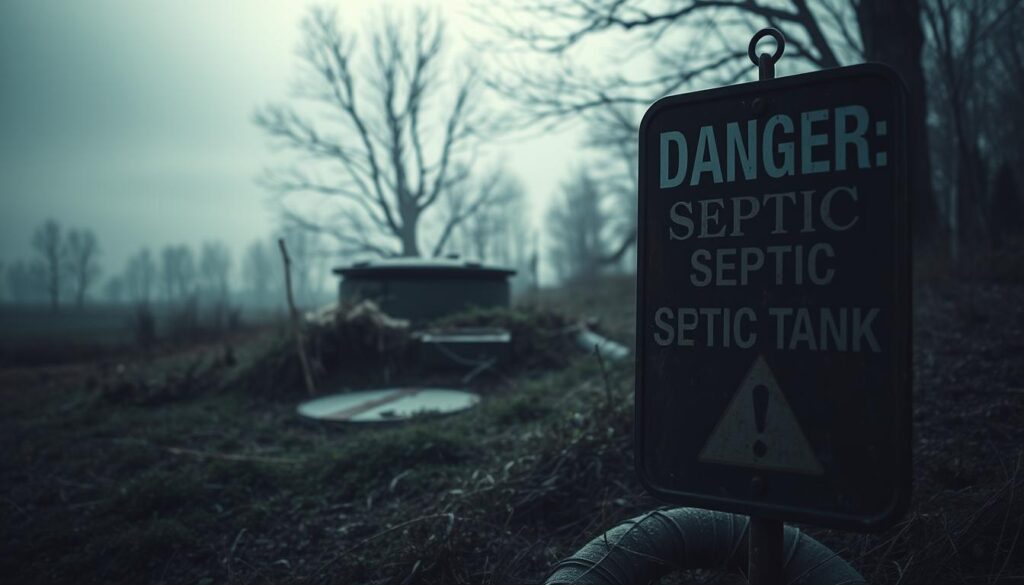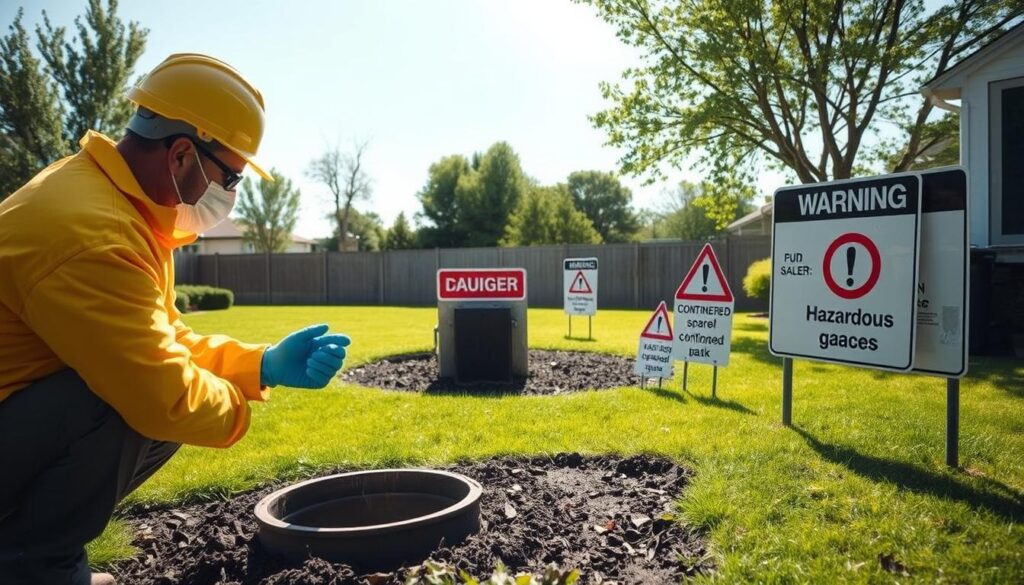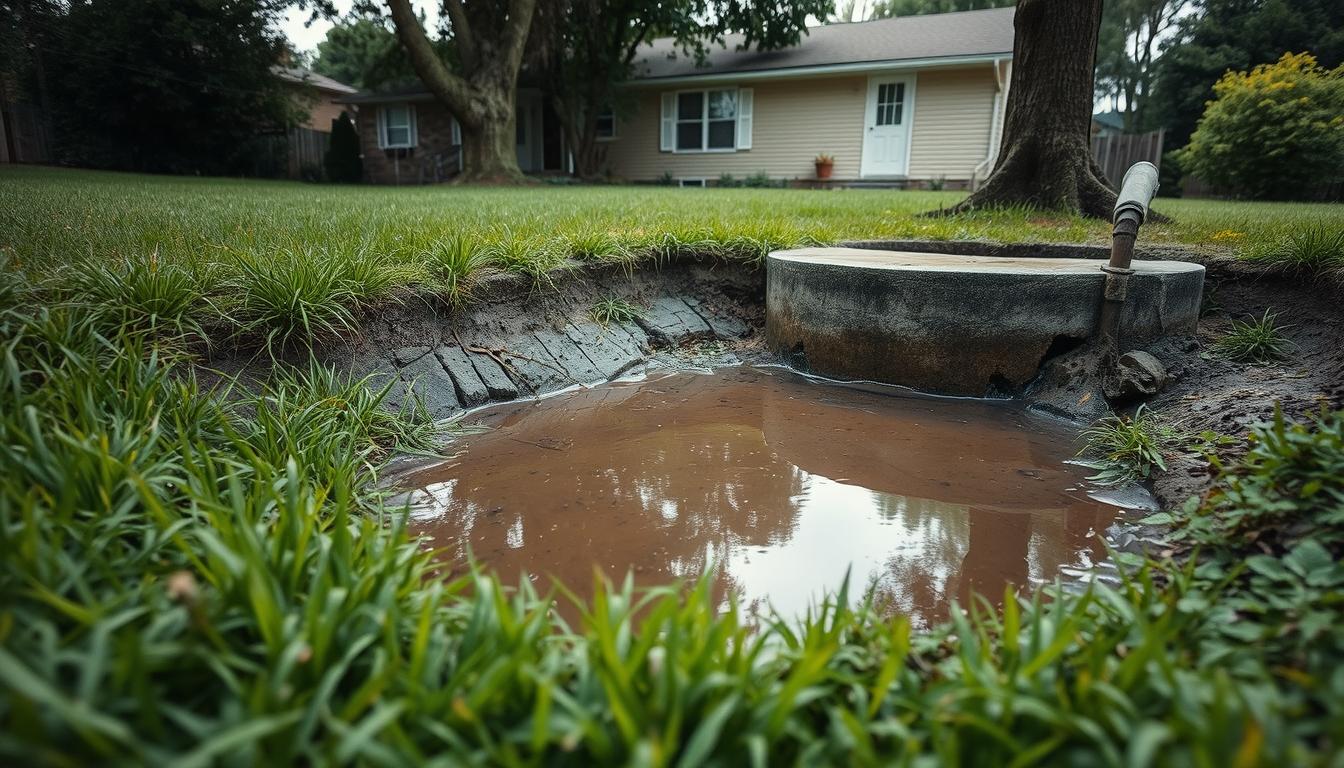Could your home’s septic system be putting you and your family at risk? Many homeowners are unaware of the potential dangers associated with poorly maintained septic tanks.
Like most components of your home, septic systems require routine maintenance. If maintained properly, a septic system should provide reliable service for many years. However, neglect can lead to serious health and environmental hazards.
Understanding the risks and taking proactive steps can help prevent costly problems and ensure your home remains safe.
Key Takeaways
- Regular maintenance is crucial for septic system longevity.
- Neglecting septic tank maintenance can lead to health hazards.
- Proper upkeep can prevent costly repairs and environmental issues.
- Homeowners should be aware of the signs of septic system failure.
- Regular inspections can help identify potential issues early.
The Hidden World Beneath Your Yard: Septic System Basics
Understanding your septic system is crucial for maintaining a safe and healthy home environment. A septic system is a complex process that treats wastewater from your household, and being aware of how it works can help prevent potential hazards.
How Septic Tanks Function in Your Home System
A septic tank is essentially a large, underground container made of concrete, fiberglass, or plastic. It processes wastewater from your home by separating solid waste from liquid waste. The solid waste settles at the bottom, forming sludge, while the liquid waste flows into the drainfield for further treatment.
Common Types of Septic Systems in American Homes
There are several types of septic systems used in American homes, including conventional, alternative, and advanced treatment systems. The type used depends on factors like soil type, groundwater level, and local regulations. Conventional systems are the most common and consist of a septic tank and a drainfield.
The Lifespan of a Typical Septic System
The lifespan of a septic system varies based on factors like maintenance, usage, and system design. On average, a well-maintained septic system can last for 20 to 30 years. Regular inspections and pumping can extend its life and prevent costly repairs.
A responsible homeowner is alert to the signs of failure, regardless of the age of the system, and responds quickly when any are discovered. Being informed about your septic system’s basics is the first step in ensuring septic tank safety and mitigating potential septic system hazards.
Are Septic Tanks Dangerous? Examining the Real Risks
Septic tanks, while essential for many homes, pose significant risks if not properly maintained. These risks can be broadly categorized into inherent risks and those related to maintenance.
Inherent Risks vs. Maintenance-Related Dangers
Inherent risks associated with septic tanks include the potential for groundwater contamination and the release of harmful pathogens into the environment. However, many of these risks can be mitigated with proper maintenance.
Maintenance-related dangers often stem from neglect or inadequate upkeep. For instance, failing to pump the tank regularly can lead to system failure, resulting in costly repairs and potential health hazards.
Statistics on Septic System Incidents in the United States
According to the United States Environmental Protection Agency (EPA), there are approximately 22 million septic systems in the United States, with about 10% failing each year. This translates to significant environmental and health risks.
| Year | Estimated Septic System Failures | Reported Incidents |
|---|---|---|
| 2018 | 2.2 million | 1,100 |
| 2019 | 2.3 million | 1,200 |
| 2020 | 2.4 million | 1,300 |
Myths and Misconceptions About Septic Dangers
One common myth is that septic systems are completely safe as long as they are pumped regularly. However, regular pumping is just one aspect of maintaining a septic system. Other factors, such as what is flushed down the drain, also play a critical role in system health.
By understanding the real risks associated with septic tanks and taking proactive measures, homeowners can significantly reduce the dangers posed by these systems.
Environmental Hazards of Failing Septic Systems
When septic systems fail, the environmental consequences can be severe, affecting both local ecosystems and human health. Untreated wastewater from failing septic systems can contaminate groundwater, surface water, and soil, leading to a range of environmental hazards.
Groundwater Contamination and Drinking Water Safety
One of the most significant risks associated with failing septic systems is groundwater contamination. Untreated wastewater can contain pathogens, nutrients, and other pollutants that can enter the groundwater, potentially contaminating drinking water sources. According to the EPA, “groundwater is a critical source of drinking water for many Americans, and contamination can have serious health implications.”
“The nation’s groundwater is a vital resource that needs to be protected from contamination. Failing septic systems are a significant threat to this resource.”
Impact on Local Watersheds and Ecosystems
Failing septic systems can also impact local watersheds and ecosystems. Nutrient-rich wastewater can stimulate excessive algae growth in surface waters, leading to eutrophication and decreased water quality. This can have cascading effects on local ecosystems, harming aquatic life and biodiversity.
EPA Regulations and Environmental Compliance
The Environmental Protection Agency (EPA) regulates septic systems under the Clean Water Act, requiring systems to meet specific design, installation, and maintenance standards. Homeowners must comply with these regulations to prevent environmental hazards. Regular maintenance and inspections are crucial to ensuring septic systems operate correctly and do not pose a risk to the environment.
By understanding the environmental hazards associated with failing septic systems, homeowners can take proactive steps to prevent these issues and protect both their health and the environment.
Health Risks Associated with Septic Tank Problems
Failing septic systems can be a breeding ground for harmful pathogens, posing significant health risks to homeowners and their families. The presence of these pathogens in septic waste is a primary concern.
Bacterial and Viral Pathogens in Septic Waste
Septic waste contains a variety of disease-causing organisms, including bacteria, viruses, and parasites. These pathogens can cause a range of illnesses, from gastrointestinal issues to more severe infections. Wastewater and sewage are particularly hazardous due to the presence of these microorganisms.
Exposure Routes: Air, Water, and Direct Contact
Individuals can be exposed to these pathogens through various routes, including contaminated air, water, and direct contact with sewage. For example, leaking septic systems can contaminate groundwater, posing a risk to drinking water safety.
Documented Illnesses Linked to Septic Failures
There are numerous documented cases of illnesses linked to septic system failures. These range from outbreaks of gastrointestinal diseases to more severe health issues. Understanding these risks is crucial for homeowners.
Protecting Vulnerable Family Members
Certain family members, such as children, the elderly, and those with compromised immune systems, are more vulnerable to the health risks associated with septic tank problems. Protecting these individuals requires awareness and proactive measures, including regular septic system maintenance and avoiding exposure to potentially contaminated areas.
Structural Dangers: When Septic Systems Threaten Your Property
When septic tanks fail, the consequences can extend far beyond the initial problem, affecting the very structure of your property. A failing septic system can cause untreated sewage to be released, potentially leading to sewage surfacing on the ground or backing up into pipes.
Sinkholes and Ground Collapse Incidents
One of the most dramatic and dangerous consequences of a failing septic system is the formation of sinkholes. When a septic tank collapses or leaks excessively, it can cause the ground above it to sink or collapse, potentially swallowing parts of your yard or even sections of your home’s foundation.
Foundation Damage from Leaking Systems
Leaking septic systems can saturate the soil around your home’s foundation, leading to structural damage. The water can cause the soil to shift or expand, putting pressure on the foundation walls, potentially leading to cracks and other forms of damage.
Tank Deterioration and Collapse Risks
Over time, septic tanks can deteriorate due to age, corrosion, or external pressures. When a tank collapses, it can release large quantities of untreated sewage into the surrounding soil, posing serious health and environmental risks.
Landscaping Damage and Yard Safety
A failing septic system can also wreak havoc on your landscaping. Areas around the septic system can become soggy or develop sinkholes, damaging lawns, gardens, and other outdoor features. Moreover, the presence of untreated sewage can make your yard a hazardous environment for children and pets.
| Risk | Description | Potential Consequences |
|---|---|---|
| Sinkholes | Ground collapse due to septic tank failure | Yard damage, foundation damage |
| Foundation Damage | Soil saturation from leaking septic systems | Cracks in foundation walls, structural instability |
| Tank Collapse | Deterioration of septic tank over time | Release of untreated sewage, environmental and health hazards |
It’s crucial for homeowners to be aware of these risks and take proactive steps to maintain their septic systems, ensuring they do not become a source of structural danger to their property.
Warning Signs Your Septic Tank Might Be Hazardous
Identifying the warning signs of a hazardous septic tank is crucial for homeowners to prevent potential disasters. Being alert to the signs of failure, regardless of the age of the system, and responding quickly when any are discovered is vital.
Visual Indicators Around Your Property
Visual cues can be strong indicators of septic tank issues. Look out for:
- Lush or soggy areas in your yard, especially over the drain field
- Standing water or sewage backups near the septic tank or drain field
- Sinkholes or areas where the ground has collapsed

Unusual Odors and Their Specific Meanings
Unpleasant odors can signal septic problems. Pay attention to:
- Persistent sewage smells inside or outside your home
- Strong odors near the septic tank or drain field
These odors can indicate that your septic system is failing to process waste properly.
Plumbing Issues That Signal Serious Problems
Plumbing issues can be a sign of larger septic tank problems. Watch for:
- Frequent drain backups or slow drains
- Toilets that are difficult to flush or gurgling sounds from plumbing fixtures
Seasonal Changes and Weather-Related Warning Signs
Seasonal changes and weather can affect your septic system’s performance. Be aware of:
- Heavy rainfall causing sewage backups or surface water ponding
- Freezing temperatures potentially causing pipes to burst or the system to fail
By being aware of these warning signs and taking septic tank inspection precautions, you can prevent hazardous situations and ensure your system operates safely.
Essential Septic Tank Maintenance to Prevent Dangers
Proper care and maintenance of your septic system can significantly reduce the risk of failures and associated dangers. Routine maintenance and proper operation will help your septic system have a long and trouble-free life.
Pumping and Cleaning Schedule
Regular pumping is a critical aspect of septic tank maintenance. The frequency of pumping depends on several factors, including the size of your tank, the number of people in your household, and your water usage habits. As a general rule, it’s recommended to pump your septic tank every 3 to 5 years.
- Inspect your tank regularly for signs of failure or potential issues.
- Keep a record of pumping and inspections to track your system’s history.
- Be mindful of what you dispose of down the drain, as excessive waste can lead to premature filling of your tank.
Professional Inspection Guidelines
Professional inspections are vital for identifying potential problems before they become major issues. It’s advised to have your septic system inspected by a professional at least once every 3 years, or more frequently if you notice any signs of failure.
During an inspection, a professional will check:
- The condition of your tank and its components.
- The drainfield for signs of failure or saturation.
- For any leaks or other potential sources of contamination.
Daily Habits for System Integrity
Simple daily habits can significantly impact the longevity and health of your septic system. Being mindful of water usage, avoiding flushing non-biodegradable items, and using septic-safe products can all contribute to a well-functioning system.
Consider these daily habits:
- Fixing leaks promptly to avoid excessive water usage.
- Avoiding the disposal of chemicals or non-biodegradable materials down the drain.
- Spreading out laundry and dishwasher use throughout the week.
Record-Keeping for Septic System Health
Maintaining detailed records of your septic system’s maintenance is crucial for its long-term health. This includes records of pumping, inspections, and any repairs or upgrades.
By keeping thorough records, you can ensure that your system is properly maintained and that any potential issues are addressed promptly.
Septic Tank Safety Precautions Every Homeowner Should Know
Septic tank safety precautions are not just recommended, they’re crucial for preventing accidents and ensuring a safe living environment. Homeowners with septic systems must be aware of the potential hazards and take proactive steps to mitigate risks.
Safe Access and Inspection Practices
When it comes to inspecting your septic tank, safety should be your top priority. Never enter a septic tank, as they are considered confined spaces and can pose a serious danger to untrained individuals. Instead, follow these guidelines:
- Ensure the tank is properly located and marked to avoid accidental damage or access.
- Use proper equipment and attire when inspecting the tank from the outside.
- Hire a professional for inspections and maintenance tasks that require specialized knowledge.
Handling Emergency Situations Without Risk
In case of a septic system failure or other emergencies, it’s crucial to act quickly and safely. Keep the following tips in mind:
- Identify the source of the problem and contain it if possible.
- Avoid direct contact with sewage or contaminated water.
- Contact a professional immediately to handle the situation.
Child and Pet Safety Around Septic Areas
Children and pets are particularly vulnerable to the dangers posed by septic systems. To protect them:
- Ensure that septic tanks and drainfields are securely fenced or covered.
- Educate children about the risks associated with septic areas.
- Supervise children and pets when they’re in areas near the septic system.

Working With Qualified Professionals
For any maintenance, inspection, or repair work, it’s essential to work with qualified professionals. They have the training, equipment, and experience to handle septic system tasks safely and effectively.
By following these septic tank safety precautions, homeowners can significantly reduce the risks associated with their septic systems, ensuring a safer home environment for everyone.
Modern Solutions to Mitigate Septic Tank Risks
Modern homeowners have access to a range of innovative solutions designed to minimize the risks posed by septic tanks. As technology advances, the ability to monitor, maintain, and upgrade septic systems has become more efficient and effective.
Advanced Monitoring Technologies
The integration of advanced monitoring technologies has revolutionized septic tank management. Systems equipped with sensors can now detect anomalies in real-time, alerting homeowners to potential issues before they become major problems. For instance, SmartSeptic systems utilize advanced telemetry to monitor tank levels, ensuring timely interventions.
Improved Treatment Systems and Upgrades
Upgrading to improved treatment systems can significantly enhance the efficiency and safety of septic operations. Modern treatment systems, such as aerobic treatment units (ATUs), offer superior waste processing capabilities compared to traditional septic tanks. According to the Environmental Protection Agency (EPA), such upgrades can reduce the risk of groundwater contamination.
Alternative Systems for Challenging Properties
For properties with challenging terrain or specific environmental conditions, alternative septic systems provide viable solutions. For example, mound systems and constructed wetlands are effective for areas with high water tables or poor soil percolation. As noted by industry experts, “Alternative systems can be tailored to meet the unique needs of a property, ensuring compliance with environmental regulations.”
Cost-Benefit Analysis of Preventative Investments
Investing in modern septic solutions requires a careful cost-benefit analysis. While initial costs may seem high, the long-term savings and reduced risk of costly failures make these investments worthwhile. A study by the National Association of Home Builders found that proactive maintenance and upgrades can extend the life of a septic system by decades, providing significant financial benefits over time.
In conclusion, embracing modern solutions for septic tank management not only mitigates risks but also enhances the overall value and safety of a property. By leveraging advanced technologies and alternative systems, homeowners can ensure their septic systems operate efficiently and sustainably.
Conclusion: Ensuring Your Septic System Remains Safe and Functional
Maintaining a safe and functional septic system is crucial for protecting your home, family, and the environment. By understanding the risks associated with septic tanks and taking proactive steps, you can prevent costly problems and ensure your system operates efficiently.
Regular maintenance is key to a safe and functional septic system. This includes regular pumping and inspections, being mindful of what you dispose of through your drains, and keeping an eye out for warning signs of potential issues. By following these guidelines, homeowners can significantly reduce the risks associated with septic systems.
Ensuring your septic system remains safe and functional requires ongoing effort, but the benefits far outweigh the costs. A well-maintained septic system not only protects your property but also contributes to a healthier environment. Take control of your septic system’s health today by staying informed and proactive.

